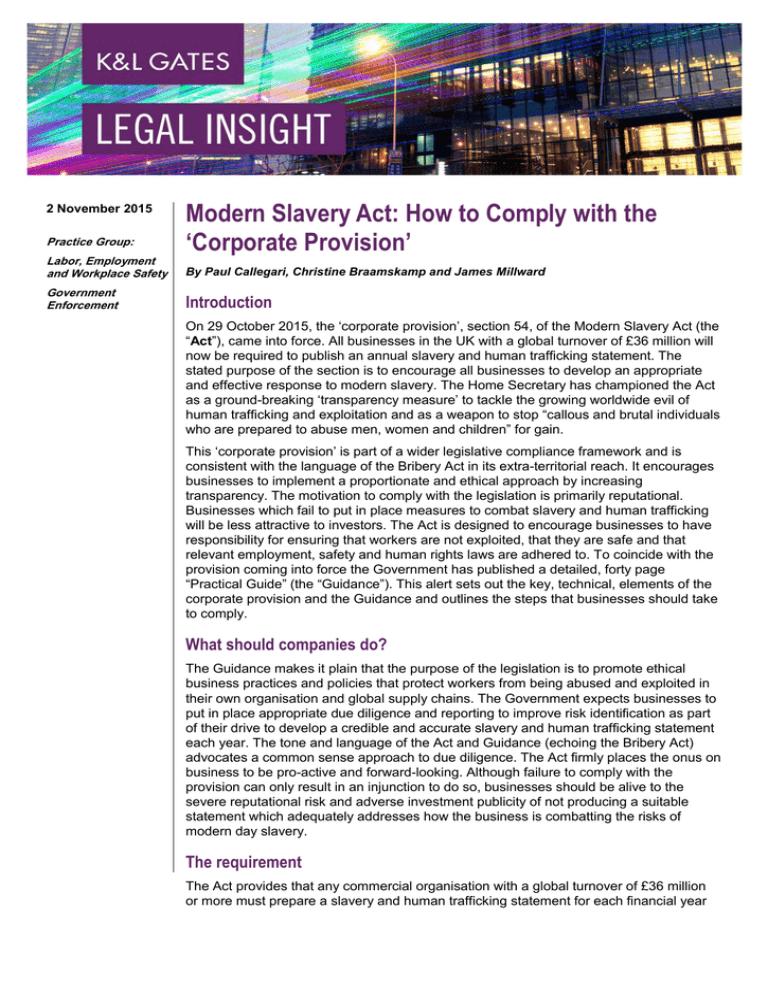
2 November 2015
Practice Group:
Labor, Employment
and Workplace Safety
Government
Enforcement
Modern Slavery Act: How to Comply with the
‘Corporate Provision’
By Paul Callegari, Christine Braamskamp and James Millward
Introduction
On 29 October 2015, the ‘corporate provision’, section 54, of the Modern Slavery Act (the
“Act”), came into force. All businesses in the UK with a global turnover of £36 million will
now be required to publish an annual slavery and human trafficking statement. The
stated purpose of the section is to encourage all businesses to develop an appropriate
and effective response to modern slavery. The Home Secretary has championed the Act
as a ground-breaking ‘transparency measure’ to tackle the growing worldwide evil of
human trafficking and exploitation and as a weapon to stop “callous and brutal individuals
who are prepared to abuse men, women and children” for gain.
This ‘corporate provision’ is part of a wider legislative compliance framework and is
consistent with the language of the Bribery Act in its extra-territorial reach. It encourages
businesses to implement a proportionate and ethical approach by increasing
transparency. The motivation to comply with the legislation is primarily reputational.
Businesses which fail to put in place measures to combat slavery and human trafficking
will be less attractive to investors. The Act is designed to encourage businesses to have
responsibility for ensuring that workers are not exploited, that they are safe and that
relevant employment, safety and human rights laws are adhered to. To coincide with the
provision coming into force the Government has published a detailed, forty page
“Practical Guide” (the “Guidance”). This alert sets out the key, technical, elements of the
corporate provision and the Guidance and outlines the steps that businesses should take
to comply.
What should companies do?
The Guidance makes it plain that the purpose of the legislation is to promote ethical
business practices and policies that protect workers from being abused and exploited in
their own organisation and global supply chains. The Government expects businesses to
put in place appropriate due diligence and reporting to improve risk identification as part
of their drive to develop a credible and accurate slavery and human trafficking statement
each year. The tone and language of the Act and Guidance (echoing the Bribery Act)
advocates a common sense approach to due diligence. The Act firmly places the onus on
business to be pro-active and forward-looking. Although failure to comply with the
provision can only result in an injunction to do so, businesses should be alive to the
severe reputational risk and adverse investment publicity of not producing a suitable
statement which adequately addresses how the business is combatting the risks of
modern day slavery.
The requirement
The Act provides that any commercial organisation with a global turnover of £36 million
or more must prepare a slavery and human trafficking statement for each financial year
Modern Slavery Act: How to Comply with the ‘Corporate
Provision’
which concludes on or after 31 March 2016. Businesses with a year-end of 31 March
2016 will be the first required to produce a statement.
Below we will set out the technical aspects of the provision and what to consider in
producing a statement.
Commercial organisation
A “commercial organisation” is defined as any body corporate or partnership that carries
on a business, or part of a business, in the UK. As with the Bribery Act 2010, the Act is
extra-territorial and businesses need not be incorporated or formed in the UK for the Act
to apply to them. Provided it falls within the definition, any organisation in any part of a
group structure will be required to comply with the provision and produce a statement.
However, where a parent and one or more subsidiaries in the same group are required to
produce a statement, the parent may produce one statement that subsidiaries can use.
Carry on business
The Guidance provides that whether a body or business can be said to be “carrying on
business” should be determined using a “common sense approach.” The organisation will
be caught if it has the relevant turnover and “engages in commercial activities” in the UK.
It is unlikely that organisations without a demonstrable business presence in the UK will
be caught and having a subsidiary in the UK will not, in itself, mean that a parent is
carrying on business in the UK.
The statement
The statement is expected to be “clear, detailed and informative” and to improve and
evolve year on year. The statement may take one of two formats. It may set out the steps
the organisation has taken during the financial year to ensure that slavery and human
trafficking is not taking place in any part of its supply chains or business. Or the
statement may simply state that the organisation has taken no such steps. The measure
is intended to bring about increased transparency in businesses and to “create a level
playing field between those businesses … which act responsibly and that need to change
their policies and procedures.”
Definition of Slavery and Human Trafficking
The Guidance adopts the definition of slavery set out in the 1926 Slavery Convention.
Slavery is defined as “the status or condition of a person over whom all or any of the
powers attaching to the right of ownership are exercised”. The key element is “the
behaviour on the part of the offender as if he / she did own the person, which deprives
the person of their freedom”. The definition of human trafficking requires that “a person
arranges or facilitates the travel of another person with a view to that person being
exploited”.
The Guidance accepts that identifying potential victims of modern slavery will sometimes
be difficult, but emphasises the responsibility that businesses have to “ensure that
workers are not being exploited, that they are safe and that relevant employment (include
wage and work hour), health and safety and human rights laws and international
standards are adhered to, including freedom of movement and communications”.
2
Modern Slavery Act: How to Comply with the ‘Corporate
Provision’
Supply chain
“Supply chain” is understood to have its everyday meaning. The Guidance explains that
the reference in the Act to ensuring that the supply chain is free of slavery and human
trafficking should not be taken to mean that the organisation in question must guarantee
that the supply chain is slavery free, simply that the organisation sets out all the actions it
has taken in relation to each part of the supply chain.
This means that if a foreign subsidiary is part of the parent company’s supply chain or
own business, the parent company’s statement should cover any actions taken in relation
to that subsidiary to prevent modern slavery.
Statement content
The statement should be succinct and written in simple language. The Act specifies six
areas of information that a business may include in its slavery and human trafficking
statement. These are not compulsory:
• Organisation structure, business and supply chains
To produce an effective statement, businesses will need to have a comprehensive
understanding of their own supply chains and structure.
• Policies in relation to slavery and human trafficking
This may simply explain how current policies and practices, programmes and
management systems already work in the business to prevent slavery. Any relevant
policies should be supported by the board of directors and senior management and
effectively communicated. The Guidance sets out some sample questions that the
business should consider when drawing up an appropriate anti- slavery policy. For
example, an organisation may put in place a specific policy to require the business only
to use specified employment agencies.
• Due diligence processes in relation to slavery and human trafficking in its business
and supply chains
Due diligence is not a requirement of the Act. However, due diligence around modern
slavery is likely to be part of a wider framework of the business’ due diligence around
ethical trade, corporate and social responsibility and human rights. Due diligence should
be proportionate to the risk and level of influence a business may have, and informed by
other risk assessments that have been conducted. Businesses are encouraged to
undertake ‘on the ground’ due diligence to investigate working conditions with support
from independent third parties.
• The parts of its business and supply chains where there is a risk of slavery and
human trafficking taking place, and the steps that it has taken to assess and manage
that risk
Businesses are encouraged to adopt risk assessments, policies and procedures that are
proportionate to their size and profile. The risks will vary according to the countries of
operation, the sector, types of transaction and supplier relationships. It is a critical part of
an effective approach to tackling slavery that a business researches and identifies risks
in order to remedy them.
• Effectiveness in ensuring that slavery and human trafficking is not taking place in its
business or supply chains, measured against key performance indicators (KPIs)
3
Modern Slavery Act: How to Comply with the ‘Corporate
Provision’
The Guidance emphasises that the business should consider whether their performance
incentives, such as buying the lowest cost products, may influence or create an
increased risk of slavery. Businesses may consider that it is appropriate to set out
information on their existing KPIs and whether they have considered the risks these bring
and whether the business has introduced any additional KPIs to ensure the performance
of anti-slavery actions undertaken.
• The training about slavery and human trafficking that is available to its staff
The Guidance confirms that training is regarded as a critical part of any business’
response to its obligations to combat slavery. Organisations should think about where
training should be targeted to have the most effect. Well trained and informed
employees, who are aware of what actions the business is taking to root out slavery and
human trafficking, will be in a better position to raise red flags.
Approval and publication
The statement must be approved by the board of directors (if a body corporate) or
equivalent management and signed by a director (or equivalent). The statement must be
published on the organisation’s website, if it has one, and there must be a prominent link
to it on the website’s home page. Where an organisation does not have a website, it must
provide a copy of the statement within 30 days to anyone who requests one in writing.
Authors:
Paul Callegari
paul.callegari@klgates.com
+44.(0).20.7360.8194
Christine Braamskamp
christine.braamskamp@klgates.com
+44.(0).20.7360.8131
James Millward
james.millward@klgates.com
+44.(0)20.7360.8227
Anchorage Austin Beijing Berlin Boston Brisbane Brussels Charleston Charlotte Chicago Dallas Doha Dubai Fort Worth Frankfurt
Harrisburg Hong Kong Houston London Los Angeles Melbourne Miami Milan Moscow Newark New York Orange County Palo Alto
Paris Perth Pittsburgh Portland Raleigh Research Triangle Park San Francisco São Paulo Seattle Seoul Shanghai Singapore
Spokane Sydney Taipei Tokyo Warsaw Washington, D.C. Wilmington
K&L Gates comprises more than 2,000 lawyers globally who practice in fully integrated offices located on five
continents. The firm represents leading multinational corporations, growth and middle-market companies,
capital markets participants and entrepreneurs in every major industry group as well as public sector entities,
educational institutions, philanthropic organizations and individuals. For more information about K&L Gates or
its locations, practices and registrations, visit www.klgates.com.
This publication is for informational purposes and does not contain or convey legal advice. The information herein should not be used or relied upon
in regard to any particular facts or circumstances without first consulting a lawyer.
© 2015 K&L Gates LLP. All Rights Reserved.
4



